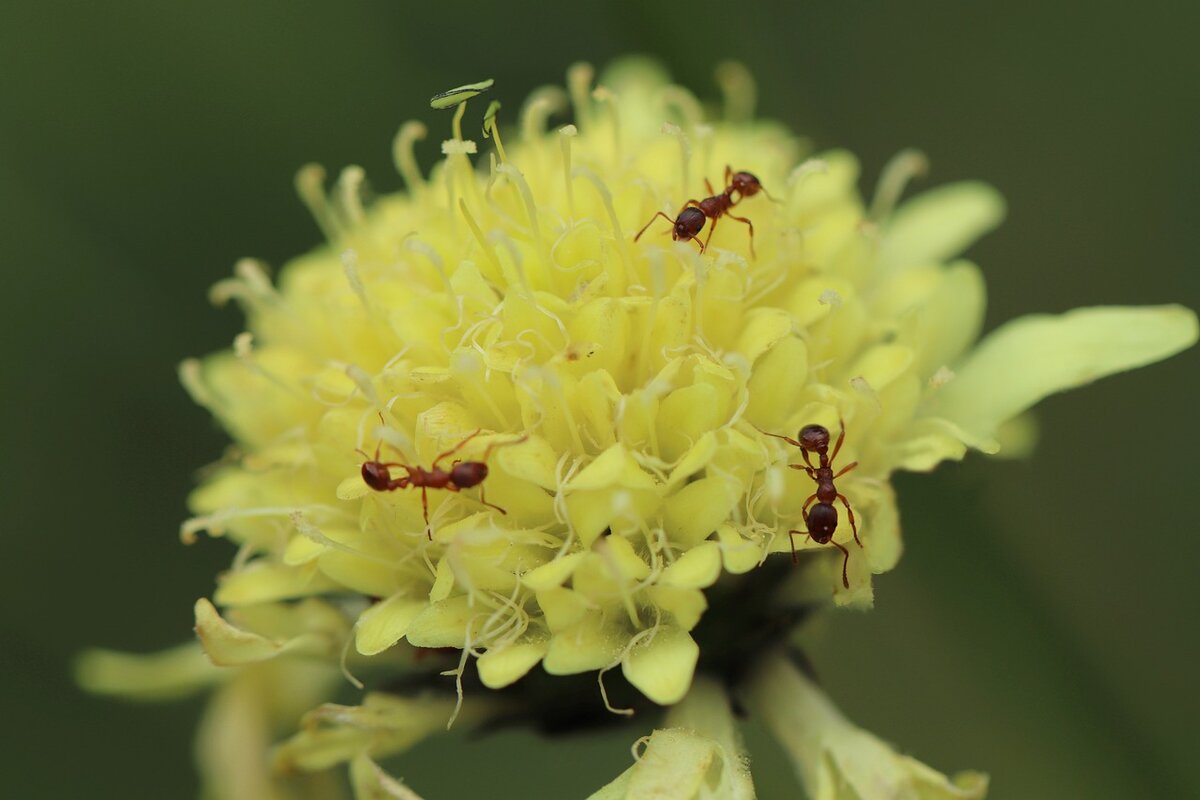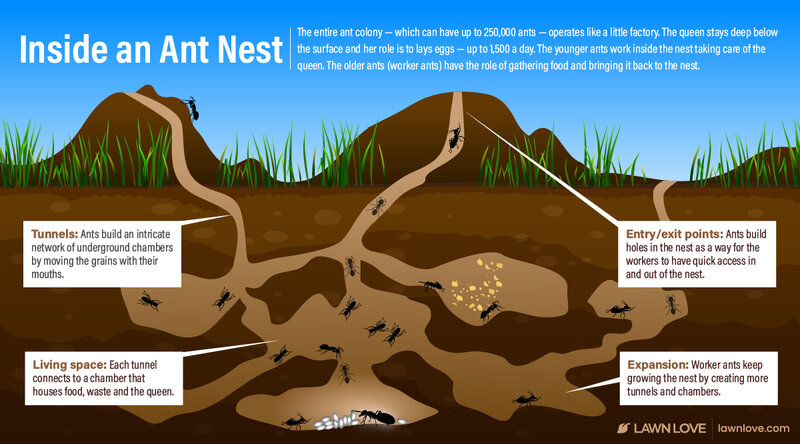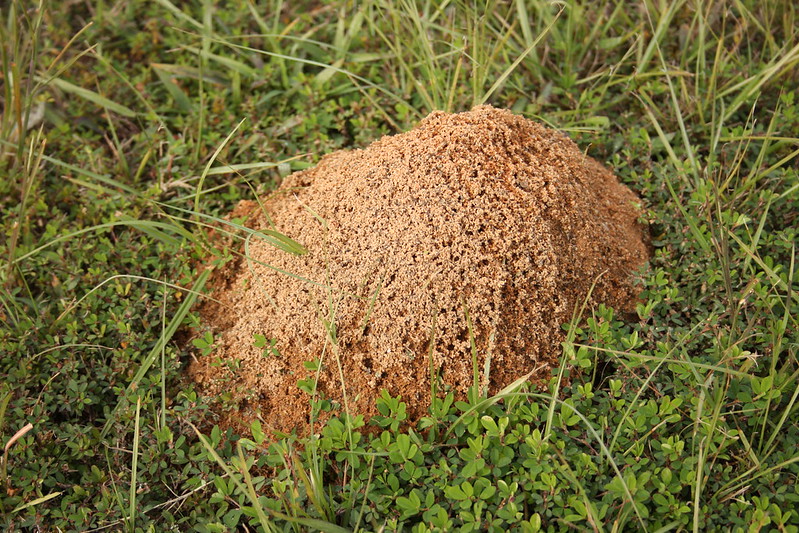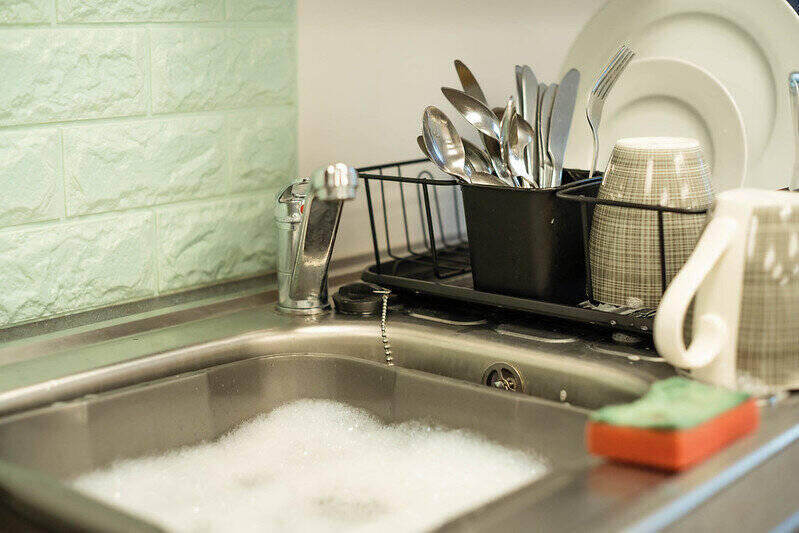
Here’s the thing about ants: They never go away completely. And you don’t necessarily want them to. Ants help control other pest populations and enrich the soil. But you still shouldn’t have to deal with ants in your home or the parts of your yard where you spend time.
So, what can you do? We’ll go over several methods for controlling your ant population, including natural remedies and commercial pesticides. Soon, you’ll know how to get rid of ants in your yard and home.
How to get rid of ants without chemicals
Pesticides should be a last resort for killing and preventing ants. There are plenty of eco-friendly, non-toxic, and cost-effective natural home remedies you can try first.
Soapy water
How to use soapy water to get rid of ants:
- Mix 1 tablespoon liquid dish soap or ¼ cup Castile soap for every quart of water.
- Spray the mixture to erase ant trails and kill ants on contact.
- Pour the mixture directly into the ant nest to wipe out the entire colony.
- Repeat treatments as needed. Soapy water will only kill the ants it comes in direct contact with. It will dry up and has no residual effects.
How it works: The soap kills ants by disrupting their cell membranes and breaking down the protective wax coating they need to survive. You can add canola oil or olive oil to the mixture to clog the ants’ spiracles (what they use to breathe) and suffocate them.
Indoor or outdoor use? Soapy water is safe to use inside and outside. Don’t spray soapy water directly on your grass or plants, as the soap can damage some plants.
Ant species this method works for: All common pest species except wood-boring carpenter ants and acrobat ants already in the walls of a home.
White vinegar

How to use white vinegar to get rid of ants:
- Mix equal parts white vinegar and water.
- Spray the mixture around outdoor living spaces and entry points into your home to repel ants and erase ant trails.
- Pour the mixture inside the ant nest to drive out the ants remaining underground.
How it works: Vinegar doesn’t kill ants. Its strong smell disturbs the pheromones ants use to communicate and find their way to food sources and then back to the nest. Erasing the scent of those pheromones with vinegar will encourage ants to leave your home and yard alone.
Indoor or outdoor use? Vinegar is best for indoor use. You also can use it outdoors in places far away from healthy grass and plants. Vinegar can harm plants and dry out the soil.
Ant species this method works for: All common pest species except wood-boring carpenter ants and acrobat ants already in the walls of a home.
Diatomaceous earth (DE)
How to use DE to get rid of ants:
- Buy food-grade DE powder (NOT industrial-grade, which is used in swimming pool filters) from any garden supply store or online.
- Spread a thin layer of the powder anywhere you’ve seen lots of ants, including around the nest or anthill.
- Spread more powder around your home’s foundation and any potential entry points (windows, doors, vents, etc) to keep ants from getting into your home.
- Reapply the DE powder after rain or watering your lawn. Water washes it away and renders it ineffective.
How it works: DE is made of microscopic crushed fossils. Even though the powder is harmless to humans and animals, those tiny pieces are razor-sharp to ants and other insects. They pierce the ants’ exoskeletons, which causes them to dehydrate and eventually die.
Indoor or outdoor use? DE powder is safe to use anywhere. It’s non-toxic to humans and pets, and it won’t harm plants.
Ant species this method works for: All common pest species except wood-boring carpenter ants and acrobat ants already in the walls of a home.
Borax / Boric acid

How to use borax or boric acid to get rid of ants:
- Mix borax powder or boric acid with sugar, syrup, peanut butter, or another food that attracts ants. Use both liquid and solid bait foods so the adult ants and larvae will eat them.
- Place the baited borax or boric acid near a place where you’ve seen lots of ants. This can be along an ant trail, close to an entry point into your home, or next to an anthill.
- Let foraging ants carry the bait back to their colony. They will share the food (and the poison) with the rest of the ants, including the queen.
How it works: Borax and boric acid aren’t exactly the same thing, but they’re two different forms of the same compound, boron. They both disrupt ants’ digestive systems when ingested and eventually kill them.
Indoor or outdoor use? This method is best for indoors and driveways, patios, or other outdoor living spaces without plants or grass. While borax and boric acid have very low toxicity for humans and pets, they can both harm plants.
Ant species this method works for: All common pest species except wood-boring carpenter ants and acrobat ants already in the walls of a home.
Baking soda / Baby powder
How to use baking soda or baby powder to get rid of ants:
- Sprinkle baking soda or baby powder (you can use them interchangeably for this method) all around ant nests, inside anthills, and along ant trails.
- Mix equal parts baking soda (not baby powder in this case) and powdered sugar. Leave the mixture in a shallow dish or lid near the nest to create an ant bait.
How it works: The tiny particles in baking soda and baby powder are just the right size to clog an ant’s spiracles (pores in their exoskeleton they use to breathe). Clogging the spiracles suffocates and kills the ant.
When ingested as bait, baking soda creates a reaction in the ant’s stomach that kills it. Foraging ants will carry the bait back to their colony, so even the ants underground (including the queen, potentially) will ingest the poison.
Indoor or outdoor use? You can use baby powder anywhere since it won’t hurt you, your pets, or your plants. Baking soda can dry out your soil and grass, so we don’t recommend spreading it in the lawn or garden. Baking soda baits that don’t touch the grass are fine.
Ant species this method works for: All common pest species except wood-boring carpenter ants and acrobat ants already in the walls of a home.
Boiling water
How to use boiling water to get rid of ants:
- Bring a large pot of water to boil.
- Rake or otherwise disturb the aboveground anthill to give you clearer access to the vast underground nest.
- Taking care not to burn yourself, slowly pour the hot water inside the ant nest. You want the water to go into the hole that leads underground.
- Repeat a few times a week until your ant problems stop or decrease as much as you want them to.
How it works: Boiling water simultaneously destroys the nest and kills the ants that come into contact with it. Because water cools down quickly underground, it may not reach the deepest parts of the colony (where the queen usually lives) while still hot enough to be fatal on contact.
Indoor or outdoor use? Boiling water is only a reasonable solution for outdoor ant nests. Unfortunately, the hot water can kill your grass and create wet, soggy spots in the yard. Only use this method if the ant nest is located in a bare patch or in the middle of a paved area.
Ant species this method works for: All common pest species nesting outdoors.
Drowning ants with your garden hose
How to use a garden hose to get rid of ants:
- Turn the hose on and soak the ant nest for about 30 minutes. Make sure as much of the water as possible goes into the hole leading to the underground colony instead of just soaking into the soil around it.
- Repeat after 24 hours.
How it works: The goal here is to fill the ants’ underground nest completely with water, drowning all the ants inside. Some ants can survive underwater for up to 24 hours, which is why you have to repeat the process.
Indoor or outdoor use? Soaking an entire ant nest is only an option for outdoor ants. Beware that so much water can drown plants and create a soggy spot in your lawn.
Ant species this method works for: All common pest species nesting outdoors.
Create a barrier with natural repellents
How to use natural repellents to get rid of ants:
- Natural ant repellents that work as barriers: vinegar, cinnamon, cayenne pepper, chili powder, powdered citrus peels, and the essential oils peppermint, cedarwood, tea tree, vetiver, and orange.
- Create a solid perimeter with a natural ant repellent all the way around the foundation of your home and the active parts of your yard (driveways, patios, play areas, other high-traffic spots). Be careful not to leave any gaps.
- Sprinkle powder repellents or use a spray bottle to spray liquid repellents around possible entry points into your home such as windows, doors, vents, or pipes.
How it works: A barrier like this won’t kill ants, and it won’t do anything about the ants already in your space. But all these repellents have strong scents that interfere with the pheromones ants use to communicate and navigate. Ants will steer clear of those smells.
Indoor or outdoor use? All the repellents listed above are non-toxic and safe to use indoors or outdoors. Note that vinegar can damage plants or grass, and spices might irritate your pets if they sniff them.
Ant species this method works for: All common pest species except wood-boring carpenter ants and acrobat ants already in the walls of a home.
How to get rid of ants with chemicals
When you’ve tried all the natural remedies you can think of and your ant infestation still persists, it’s time to turn to chemical insecticides.
Remember that pesticides like these should be a last resort. They kill pollinators and other beneficial insects that actually help your lawn and garden. Pesticides in your lawn also can run off with the rain and pollute sources of drinking water.
Commercial ant baits
How to use commercial ant baits to get rid of ants:
- When you purchase ant baits, check the packaging to see if they’re intended for indoor or outdoor use. Choose whichever type of bait suits your needs.
- Set up multiple bait stations (aka “traps”) in areas where you’ve seen ants foraging.
- Don’t kill ants when you see them coming to and from the trap. Let them carry the bait back to the colony.
- Replace or refill the bait stations about every three months, if necessary. The time between refills may vary by product, so follow the instructions that come with your bait.
How it works: In general, commercial baits contain something ants want to eat mixed with a chemical that will kill them. Scout ants carry the food — and the poison with it — back to their colony, where all the ants, including the queen, will eventually eat it and die.
Indoor or outdoor use? Check the label on your bait’s package to find out if it’s safe to use indoors or only outdoors. All commercial ant baits contain toxic chemicals, so don’t place them somewhere a young child or pet can get to them.
Ant species this method works for: All common pest species except wood-boring carpenter ants and acrobat ants already in the walls of a home; need special fire ant baits for effective fire ant control.
Commercial insecticides
How to use commercial insecticides to get rid of ants:
- Purchase a liquid or granular insecticide labeled for use against ants. If you have fire ants, you’ll need a special fire ant killer because they resist many insecticides.
- Check the label for whether you can use the insecticide indoors, outdoors, or both.
- Following the instructions on the label, spray the liquid or spread the granules in a perimeter around the foundation of your home and outdoor living spaces to keep ants out.
- For outdoor ant colonies, remove the top of the anthill and pour the insecticide directly into the ant nest to kill the ants remaining underground.
How it works: Different insecticides use different chemicals, which all kill ants in different ways. Non-bait pesticides only kill the ants that come in direct contact with them.
Ant baits will take longer to work than contact insecticides but are usually more effective at taking out entire colonies. With contact pesticides, there’s less of a chance of killing the queen.
Indoor or outdoor use? Some insecticides are made for indoor use and some for outdoor use. Check the label. Again, always keep young children and pets away from chemical pesticides.
Ant species this method works for: All common pest species except wood-boring carpenter ants and acrobat ants already in the walls of a home; need special fire ant insecticides for effective fire ant control.
Lawn care to prevent ants
You might be creating a perfect environment for ants without even knowing it. Ants like sparse lawns with lots of bare patches. You’re less likely to find ants in a dense lawn full of healthy, green grass.
Here are some lawn care tips to help you prevent ants from ever nesting in your yard in the first place:
- Mow the lawn once a week during your grass’s growing season to the recommended height for your grass type. Never cut more than one-third of the grass’s height at a time.
- Water the lawn well, especially in summer when the heat evaporates a lot of the water in your soil. Most grass types need about an inch of water per week during their growing season.
- Fertilize the lawn on a regular schedule. The best schedule for you will depend on your grass type and what fertilizer you use. You’ll usually fertilize every few months for a healthy lawn.
- Aerate and dethatch annually to improve circulation in your soil and give the grass’s roots better access to water and nutrients. Compacted soil can kill your grass and create bare patches where ants would love to build a nest.
About ants
If you want to know the best way to kill ants, you first have to understand how they live.
Ant colonies

The most important thing to know about ants is that they always live and work in colonies. Ants are so wired to work together that you could even think of an ant colony as one big superorganism.
When you spot-kill a handful of ants at a time, you do little harm to the overall “organism” of the colony. Killing a few ants is the equivalent of pulling out a few hairs in a human. You have to wipe out the entire colony if you want your infestation to end.
Queen ants
All ant colonies depend entirely on their queen, or for some species, multiple queens. The queen ant finds the site of the nest and lays all the eggs. She is the only female in the colony that can reproduce, which means without her, the colony dies.
The flip side is that as long as the queen ant lives, the colony can rebuild itself. Kill a thousand of the queen’s worker ants, and she’ll just replace them. In some species, the queen ant can lay thousands of eggs in a day.
Bottom line: You MUST kill the queen to wipe out an ant colony. That can be difficult since the queen often stays in a safe chamber deep underground. Ant control treatments that kill on contact likely won’t reach her, which is why baits are usually more effective.
Ant nests

The anthill (aka ant mound) you see on your lawn is just like the tip of an iceberg. The actual nest extends 2 to 3 feet below the surface and 2 to 4 feet out from the base of the anthill. Scattering an ant mound and killing the ants that scurry out barely scratches the surface of the nest and population.
Ant trails
At some point in your life, you’ve seen ants marching in a row. Those ants are following a trail of pheromones, aka an “ant trail,” that a scout ant in the colony created to lead other ants to a food source.
One way to keep ants out of your space is to disrupt those ant trails with an overwhelming foreign scent. Pungent repellents like vinegar and essential oils are great for masking pheromone trails leading into your home or outdoor living space.
When to call a professional exterminator
Any time you have a severe ant infestation inside your home, calling a professional exterminator is a good idea. Many species of ants will nest in hard-to-reach places like the inside of walls, and a pro is the best person to locate and destroy those nests.
You should be able to handle most outdoor ant infestations on your own. But if you try all the methods we described in this guide and nothing works, it’s time to call a pro.
Remember, you can prevent ants from ever infesting your yard with a lawn care management program. Mowing, watering, and fertilizing correctly will keep your grass thick, healthy, and ant-free. Lawn Love’s local lawn care professionals are always on hand to help.
Main Photo Credit: Annette Meyer | Pixabay




